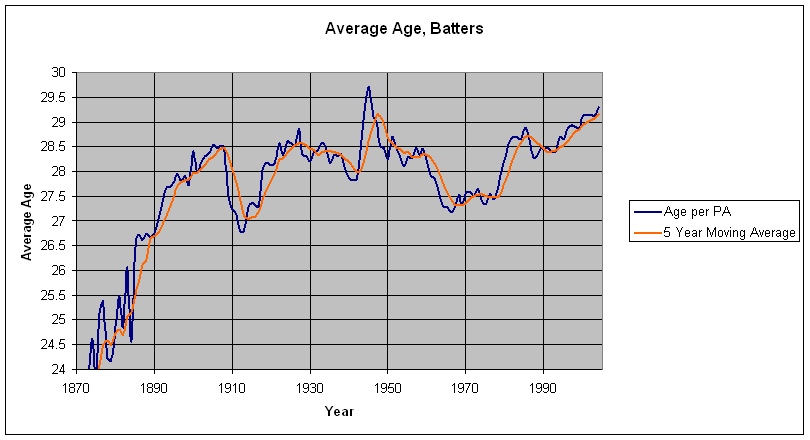 |
 |
|
March 29, 2005
How Old are You Now?
The Boston Herald continues its series on the state of baseball with a look at the aging of players: Take a guess how many of today's major leaguers are under 21? Sometimes, however, perceptions don't reflect reality. The Lahman database has enough information to create charts of age for the major leagues. Plotted below are the average age of batters, weighted by plate appearances, and the average age of pitchers, weighted by innings pitched. Click on each graph to get a larger view. Indeed, the trend in age is up. It's also pretty clear that the money generated by free agency is a big reason. There was a huge dip from around 1950 to 1970 in age. During that time, the owners cemented their grip on the players with the reserve clause and the amateur draft. Unless you were a superstar, there was no reason to stay in baseball into your late 30s. The start of the trend up corresponds to the free agent era. From the article: There are good and plentiful reasons why today's players hang around, or try to, longer than their counterparts of yesteryear. For one thing, superior conditioning methods (and in some cases, chemical enhancement) mean that they can linger. For another, modern-day salaries offer an irresistable inducement. A few generations back, a 35-year-old future Hall of Famer could make more money selling cars, with less risk of embarrassment, than he might have with another year's baseball salary. Moreover, in today's free-spending baseball world, the only way some teams can sign free agents is by offering long-term, multi-year, guaranteed contracts likely to extend well beyond the useful shelf life of the player. One thing many have noticed about the numbers generated by the probabilistic model of range is that it was a below average year for baseball in general. Could part of this be having older players taking the field? If not for the anomaly of World War II, 2004 would have had the oldest batters (and position players) in the history of baseball. I have to believe that's hurting defense. As I think about a number of teams this season, I'm struck by how old they are getting. The Giants, Yankees and Red Sox look especially long in the tooth to me. Last year was the year of the old player. Will this be the year that age catches up to them? Baseball Musings is holding a pledge drive during March. Click here for details. Comments
Don't discount the DH rule, either. Posted by: Linkmeistet at March 29, 2005 02:14 PMFascinating article and charts. Yes, almost nothing declines faster with age than fielding performance. Question for the house: why did the average age of batters and pitchers nosedive around 1908-12? Expansion occurred in 1901, the First World War did not reach America until 1917. The Federal League opened in 1914. Might there have been poaching of "major league" players by the "minor" leagues such as the PCL? Posted by: MichaelHumphreys at March 29, 2005 02:14 PMPost a comment
|
|




